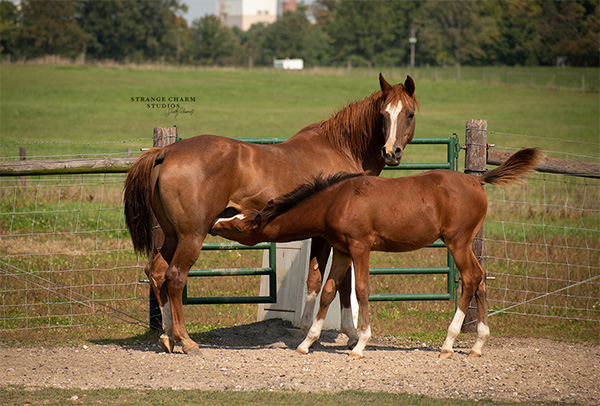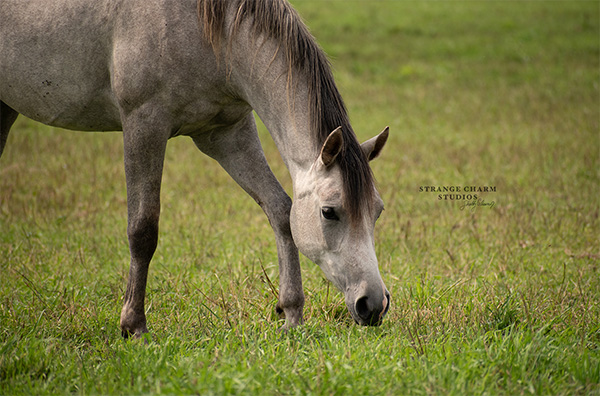How Much Protein Does Your Horse Really Need?
EC Blog by: Shelby Glessner
Horse owners often spend a lot of time and money on formulating a perfect feeding regimen for their herd. As one of the key nutrients, protein receives a lot of attention in these discussions, and companies often market protein-dense feeds for young or hard-working horses. But how much protein does a horse really need in their diet?
Why feed protein?
Proteins are structural components and, in some cases, communicators within the body. All living things need to take in some amount of protein to remain healthy and functional. Proteins are made up of units called amino acids. Possessing a variety of chemical properties, around 20 amino acids are considered essential, meaning they must be ingested by the animal and cannot be synthesized elsewhere within the body.
Mature Horses at Maintenance
In natural situations, the protein requirements of an average mature horse will be met easily by grazing, provided that the pasture is of adequate quality. If fresh pasture is not available, a proper amount of hay will also satisfy their needs. Note that some forages are higher in protein than others: Legume plants such as alfalfa are a popular choice as a protein rich forage for horses.
Mares and Foals
Somewhat surprisingly, the nutritional requirements of a pregnant mare do not increase dramatically until around the third trimester of gestation. Up until this time, it is reasonable to feed a pregnant mare as if she were a horse at maintenance.
Once the foal’s feet hit the ground, this sprightly youngster will require plenty of protein in his diet. A young horse’s body is busy growing and building up structure, utilizing protein as the building blocks. Mom needs plenty of protein too: a lactating mare is not only attempting to maintain her own body condition, but especially in early stages, she is providing all the protein to the foal through the milk as well. This is one of the reasons it can seem difficult to keep a mare in good body condition around foaling and as she begins lactating.
Many horse owners seem to fall under the assumption that performing horses such as jumpers, endurance horses, and working draft horses need an extra high-protein diet to be successful athletes. This is certainly not necessarily the case. While these horses may indeed need a slightly increased amount of protein to repair bodily structures stressed by performance, they are (in most cases) simply a typical mature horse at work. The car has already been built; we just need to put gas in it! Focusing our attention toward a well-balanced diet with proper energy to protein ratios is a more practical choice, not only with our equine athletes, but any horse.
Feeding for Cold Weather
As cold weather approaches, many horse owners are considering their “winterizing” routines. Before bulking up on your commercial grain rations, let’s consider the digestive processes of horses. Horses are known as “hind gut fermenters,” meaning that the main digestive mechanism is a fermentation process in the intestines. As we might suppose, fermentation produces heat, and in this case, is part of what can keep a horse warm. Nutrients such as proteins and simpler carbohydrates in grain concentrates don’t contribute much to fermentation, but fiber in forages certainly does! Because of this, rather than increasing your horse’s protein or overall grain intake, provide them with plenty of hay to keep the fermentation active and producing heat.
Commercial Grains
Commercial grain feeds are formulated by nutritionists to provide balanced diets. When fed the appropriate amount as indicated on the tag, a typical horse should reach all their nutritional requirements without additional top dressing or supplementation. It is generally not advisable to add such extra constituents to a diet that has already been balanced.
That being said, it is also important to make informed decisions regarding which type of commercial grain you choose. Some feed companies boast specialized high-protein feeds with flashy packaging… and a flashy price tag to match. These feeds may have a “crude protein” content of 20% or more, far outreaching the general maintenance horse protein requirement of around 13%. The excess protein may be fed to the horse but not actually utilized and will simply be excreted in the urine. Additionally, crude protein is a measurement of the amount of nitrogen in the feed (nitrogen is a fundamental constituent of all amino acids), not a measure of the specific amino acid profile of the feed. As a result, the crude protein measurement tells us nothing about the actual quality of the protein (remember that quantity does not equal quality). Considering these factors, you may very well be wasting your money on a product your horse’s body isn’t even able to utilize.
There are also environmental concerns surrounding an overconsumption of proteins. As previously mentioned, any excess protein will be excreted in the urine in the form of ammonia. This smelly chemical can accumulate in stalls and cause respiratory irritation for horses and humans alike. It can also contribute to agricultural runoff situations which, in large scales, cause problems in groundwater and aquatic ecosystems.
As always, trust the recommendation of a veterinarian for your horse’s specific situation. Just like humans, horses with different bodies will have different needs, and there is not a hard-and-fast rule regarding how you should choose to feed your equine partner.
References
Kentucky Equine Research Staff. “Importance of Dietary Protein in Horses.” Kentucky Equine Research, 9 Jan. 2018, ker.com/equinews/importance-dietary-protein-horses/.
“The Sources and Solutions: Agriculture.” EPA, Environmental Protection Agency, 30 July 2020, www.epa.gov/nutrientpollution/sources-and-solutions-agriculture.
About the Author
Shelby Glessner is a senior student at Michigan State University studying Animal Science and the equine industry. She spent an academic year working with renowned researcher Dr. Stephanie Valberg in the Equine Neuromuscular Diagnostic Lab at MSU’s College of Veterinary Medicine and has undertaken extensive science and equine related coursework. Passionate about education, she hopes to pursue a career advocating for research-based practices in animal agriculture.












